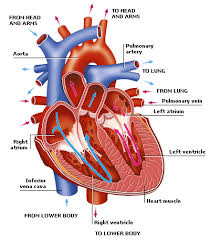Circulatory System
The Circulatory System is responsible for transporting materials throughout the entire body. It transports nutrients, water, and oxygen to your billions of body cells and carries away wastes such as carbon dioxide that body cells produce. It is an amazing highway that travels through your entire body connecting all your body cells.
Parts of the Circulatory SystemThe circulatory System is divided into three major parts:
a. The Heart
b. The Blood
c. The Blood Vessels
2. What are the structures and the functions of the human heart?
The Heart is an amazing organ. The heart beats about 3 BILLION times during an average lifetime. It is a muscle about the size of your fist. The heart is located in the center of your chest slightly to the left. It's job is to pump your blood and keep the blood moving throughout your body.
The heart lies within the pericardium, a sac which contains a small quantity of lubricating liquid. The heart has 4 chambers: 2 upper, thin walled atria and 2 lower thick walled ventricles.
- left and right atria - The left atrium sends blood through an atrioventricular valve to the left ventricle. The right atrium atrium sends blood through an atrioventricular valve to the right ventricle.
- left and right ventricles - the left ventricle sends blood throught the aortic semilunar valve into the aorta to the body. The right ventricle sends blood throught the pulmonary semilunar valve into the pulmonary trunk and the pulmonary arteries to the lungs.
- coronary arteries and veins - Important part of the systemic circuit they serve the heart muscle itself. The coronary areteries are the first branches off the aorta. The coronary capillary beds on the exterior of the heart join to form venules. The venules converge to form cardiac veins which empty into the right atrium.
- anterior (superior) and posterior (inferior) vena cave - both carry deoxygenated blood (low O2 high CO2) to the right atrium. Superior collects from the head chest and arms. Inferior collects from the lower body regions.
- aorta - The path of the systemic blood to any organ in the body begins in the left ventricle, which pumps blood into the aorta.
- pulmonary arteries and veins - Pulmonary arteries carry deoxygenated to the lungs from the heart. Pulmonary veins carry oxygenated blood to the heart from the lungs.
- pulmonary trunk - Blood from all regions of the body first collects in the right atrium and then passes into the right ventricle, which pumps it into the pulmonary trunk. The pulmonary trunk divides into the pulmonary arteries to each lung.
- atrioventricular valves - The valves between the atria and ventricles. Supported by strong fibrous strings called chordae tendineae that prevent the valves from inverting. Prevent the backflow of blood into the atria after it has entered the ventricle.
- chordae tendineae - that prevent the atrioventricular valves from inverting
- semi-lunar valves - between the ventricles and their attached vessels. The pulmonary semilunar valve lies between the right ventricle and the pulmonary trunk. The aortic semilunar valve lies between the left ventricle and the aorta.
- septum - A wall that seperates the heart into a right side and a left side
3. How does the heart work?
The heart is actually a muscle that works like a pump in distributing blood throughout the body. The heart has four chambers. The two at the top are the left and right atria and the two at the bottom are the left and right ventricles. Blood vessels lead in and out of these chambers.
Oxygenated blood from the lungs flows into your heart and is then pumped out to the rest of your body. Once the blood has delivered the oxygen to the tissues of the body, it returns to your heart and gets pumped back out to the lungs where it will be re-oxygenated.
a. Veins - carry blood back toward your heart.
b. Arteries - are blood vessels that carry oxygen rich blood AWAY from the heart.
c. Capillaries - are tiny blood vessels as thin or thinner than the hairs on your head. Capillaries connect arteries to veins. Food substances(nutrients), oxygen and wastes pass in and out of your blood through the capillary walls.
d. Blood vessels - to carry blood throughout the body. Arteries and veins are the largest of the blood vessels. Arteries move blood, which contains oxygen and nutrients to muscles and organs and veins carry the blood back to the heart.
5. What is the chemical composition of the blood?
a. Plasma, which is a clear extracellular fluid
b. Formed elements, which are made up of the blood cells and platelets
The formed elements are so named because they are enclosed in a plasma membrane and have a definite structure and shape. All formed elements are cells except for the platelets, which tiny fragments of bone marrow cells.
Formed elements are: Erythrocytes, also known as red blood cells (RBCs), Leukocytes, also known as white blood cells (WBCs), Platelets



Comments
Post a Comment